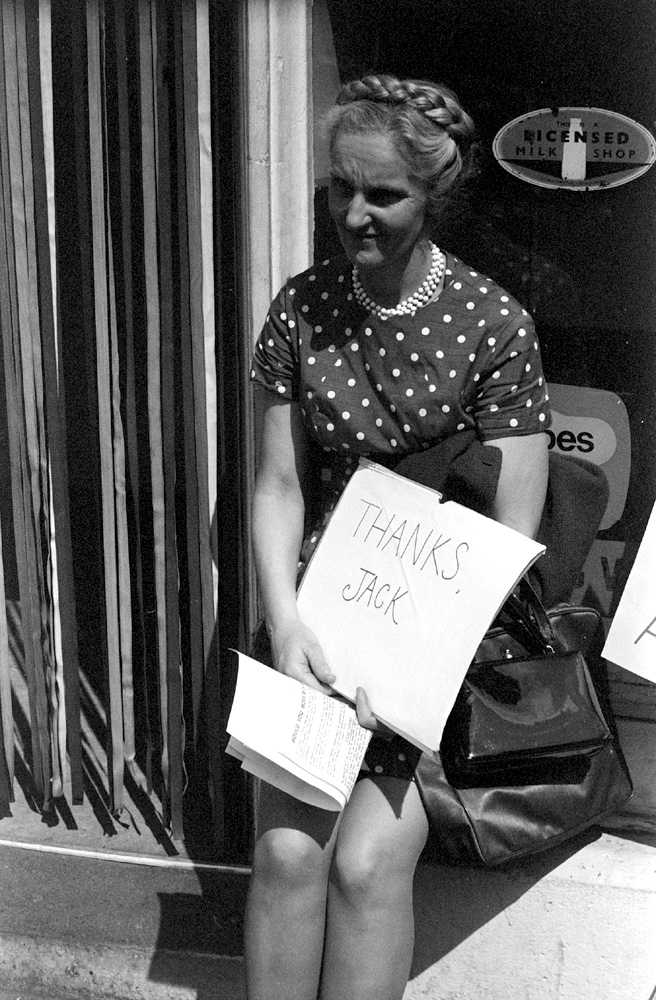The Dictionary of Sydney was archived in 2021.
The Dictionary of Sydney was archived in 2021.
 Jack Mundy, Builders Labourers Federation, 1973 by Rennie Ellis © Rennie Ellis Photographic Archive
Can you imagine Sydney without The Rocks? or what if we didn't have the Centennial Parklands or the State Theatre? These are just some of the iconic Sydney places that were saved from wholesale destruction in the 1970s by the imposition of green bans by trade unionists.
Listen to Lisa and Alex on 2SER here
Jack Mundy, Builders Labourers Federation, 1973 by Rennie Ellis © Rennie Ellis Photographic Archive
Can you imagine Sydney without The Rocks? or what if we didn't have the Centennial Parklands or the State Theatre? These are just some of the iconic Sydney places that were saved from wholesale destruction in the 1970s by the imposition of green bans by trade unionists.
Listen to Lisa and Alex on 2SER here
Traditionally trade unionists placed a 'black ban' on work or goods to push their own issues. But in the 1970s trade unionists in the construction industry began to use the withdrawal of labour to highlight their social responsibility. They argued that workers had a right to insist their labour not be used in harmful ways.
In order to distinguish from black bans, this new concept was given a new name, a green ban.
Sydney was one of the first places in the world to have green bans. There were three main types of green bans:
- to defend open spaces from various kinds of development;
- to protect existing housing stock from demolition intended to make way for freeways or high-rise development;
- to preserve older-style buildings from replacement by office-blocks or shopping precincts.
One of the key figures behind the green bans was
Jack Mundey.
He worked as a builder’s labourer and became an outspoken and active leader of the Builders’ Labourers Federation (BLF). He was Secretary of the NSW branch of the BLF from 1968 to 1975. Jack Mundey and the green bans were familiar household words in the 1970s.
wp-image-18031https://home.dictionaryofsydney.org/wp-content/uploads/2021/03/SLNSW_ON-161-Item-293.jpgJack Mundey, candidate for Canterbury in the NSW State elections, speaking in Campsie shopping centre on a Saturday morning 17 February 1968, [ON 161/Item 293] (Mitchell Library, State Library of NSW, and Courtesy Tribune / SEARCH Foundation)286426/> Jack Mundey, candidate for Canterbury in the NSW State elections, speaking in Campsie shopping centre on a Saturday morning 17 February 1968, [ON 161/Item 293] (Mitchell Library, State Library of NSW, and Courtesy Tribune / SEARCH Foundation)
The Green Ban movement preserved many of Sydney’s historic sites from demolition and saved the inner-city suburbs of Woolloomooloo and The Rocks from unfettered development, as well as much of Glebe and many iconic Sydney buildings like the State Theatre, the Pitt Street Uniting Church, and the beautiful Royal Australasian College of Physicians building on Macquarie Street.
But it was never just about the built environment. Green bans were as much about people, the importance of what we now call affordable housing and social equity. The movement saved many inner-city tenants of low-cost rental homes from eviction and whole communities from disruption and dislocation.
For more detail about some of the sites and communities protected by green bans, and their ongoing impact, see our excellent article by Meredith Burgmann and Verity Burgmann
here.
The Green Bans were highly politicised. Internal dissension within the Builders’ Labourers Federation led to Mundey's expulsion, but that didn't stop his activism. Jack Mundey was elected to Sydney Council on the Communist Party of Australia ticket and represented resident action groups from 1984 to 1987.
Mundey was a committed environmentalist and was a national councillor with the Australian Conservation Foundation for 11 years. He was appointed chair of the NSW Historic Houses Trust in 1995, and in 2000 he was made an Officer in the Order of Australia.

'Thanks Jack' Builders Labourers Federation Protest 1973 by Rennie Ellis © Rennie Ellis Photographic Archive
Jack Mundey died last year, and his contribution to our community is being recognised with a State Memorial Service today (Wednesday 10 March). The service will be live streamed from 11am from Sydney Town Hall here:
https://www.nsw.gov.au/state-funerals/state-memorial-for-jack-mundey-ao and will be recorded for later viewing too.
Dr Lisa Murray is the Historian of the City of Sydney and former chair of the Dictionary of Sydney Trust. She is the 20201 Dr AM Hertzberg AO Fellow at the State Library of New South Wales and the author of several books, including Sydney Cemeteries: a field guide. She appears on 2SER on behalf of the Dictionary of Sydney in a voluntary capacity. Thanks Lisa, for ten years of unstinting support of the Dictionary! You can follow her on Twitter here: @sydneyclio
Listen to Lisa & Alex here (skip to 136.08!) and tune in to 2SER Breakfast on 107.3 every Wednesday morning at 8:15-8:20 am to hear more from the Dictionary of Sydney.
 Jack Mundy, Builders Labourers Federation, 1973 by Rennie Ellis © Rennie Ellis Photographic Archive
Jack Mundy, Builders Labourers Federation, 1973 by Rennie Ellis © Rennie Ellis Photographic Archive





